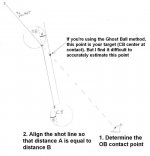Hill-Hill & You're Shooting the 9 For the Dough.
Talk me through you're thought process in regards to how you line up (or aim) this shot. Maybe thought process isn't the right term but you get the idea.
The picture is intended to be a nine ball near the center of the table with the cue ball just inside the kitchen a few inches but on the same line as the nine. You need not consider this shot exactly, I'm more just interested in how you would go about aiming a high pressure, difficult shot.
For me, I'm sort of reworking my approach to such shots so that's why I ask the question. When it comes to aiming I'm more of a simple overlaper, but there are shots that give me nightmares and this is one of them. Lately, in order to find the proper overlap spot I've been starting with the edge to edge point and then sliding further into the object ball until i see the right overlap. Then I lock in and approach the table.
On such shots are you totally confident with your method? Or do you employ a different or additional one?
I'll take my answers off the air.
Thanks
Talk me through you're thought process in regards to how you line up (or aim) this shot. Maybe thought process isn't the right term but you get the idea.
The picture is intended to be a nine ball near the center of the table with the cue ball just inside the kitchen a few inches but on the same line as the nine. You need not consider this shot exactly, I'm more just interested in how you would go about aiming a high pressure, difficult shot.
For me, I'm sort of reworking my approach to such shots so that's why I ask the question. When it comes to aiming I'm more of a simple overlaper, but there are shots that give me nightmares and this is one of them. Lately, in order to find the proper overlap spot I've been starting with the edge to edge point and then sliding further into the object ball until i see the right overlap. Then I lock in and approach the table.
On such shots are you totally confident with your method? Or do you employ a different or additional one?
I'll take my answers off the air.
Thanks

